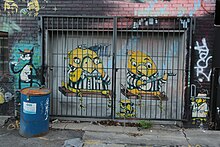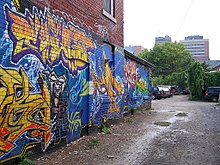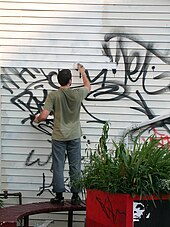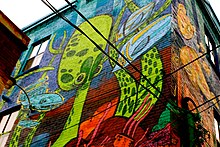
Graffiti is art that is written, painted or drawn on a wall or other surface, usually without permission and within public view. Graffiti ranges from simple written words to elaborate wall paintings, and has existed since ancient times, with examples dating back to ancient Egypt, ancient Greece, and the Roman Empire.

An alley or alleyway is a narrow lane, path, or passageway, often reserved for pedestrians, which usually runs between, behind, or within buildings in the older parts of towns and cities. It is also a rear access or service road, or a path, walk, or avenue in a park or garden.

A street artist is a person who makes art in public places. Street artists include portrait artists, caricaturists, graffiti artists, muralists and people making crafts. Street artists can also refer to street performers such as musicians, acrobats, jugglers, living statues, and street theatre performers. Street artists can be seen throughout the world.

Coxwell is a subway station on the Line 2 Bloor–Danforth in Toronto, Ontario, Canada. The station is located on Strathmore Boulevard just east of Coxwell Avenue and one block north of Danforth Avenue. It opened in 1966 as part of the original segment of the Bloor–Danforth line. Automatic sliding doors, accessible fare gates and the addition of elevators made the station fully accessible in late December 2017.

Street art is visual art created in public locations for public visibility. It has been associated with the terms "independent art", "post-graffiti", "neo-graffiti" and guerrilla art.
Mural Arts Philadelphia is a non-profit organization that supports the creation of public murals in Philadelphia, Pennsylvania. Founded in 1986 as Mural Arts Program, the organization was renamed in 2016. Having ushered more than 3,000 murals into being, it calls itself "the nation’s largest public art program". As of 2022, the organization says it runs 50 to 100 public art projects each year; it also works to maintain existing murals.

Centre Place is a laneway and pedestrian precinct in Melbourne, Australia. It runs north from Flinders Lane to Collins Street, between Elizabeth Street and Swanston Street.

Degraves Street is a pedestrian precinct and thoroughfare in the Melbourne central business district in Victoria, Australia. It is a short, narrow laneway that runs north–south from Flinders Street to Flinders Lane and is situated in-between Swanston and Elizabeth streets. Degraves, as the street is colloquially known, is famous for its alfresco dining options and because it epitomises Melbourne's coffee culture and street art scene. For these reasons it has also become a popular tourist destination.

Melbourne, the capital of Victoria and the second largest city in Australia, has gained international acclaim for its diverse range of street art and associated subcultures. Throughout the 1970s and 1980s, much of the city's disaffected youth were influenced by the graffiti of New York City, which subsequently became popular in Melbourne's inner suburbs, and along suburban railway and tram lines.
Benjamin Flynn, known professionally as Eine, is an English artist based in London.

Stephen J. Powers is an American contemporary artist and muralist. He is also known by the name ESPO, and Steve Powers. He lives in New York City.

Hosier Lane is a laneway in the central business district (CBD) of Melbourne, Victoria, Australia. Located on the CBD's southern edge, it extends between Flinders Street and Flinders Lane, and opens opposite the Atrium at Federation Square. Since the late 1990s, Hosier Lane has become a popular tourist attraction due to its street art.
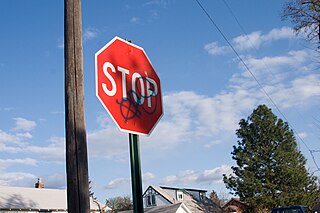
Graffiti are writing or drawings scribbled, scratched, or sprayed illicitly on a wall or other surface in a public place. Graffiti ranges from simple written words to elaborate wall paintings. Graffiti, consisting of the defacement of public spaces and buildings, remains a nuisance issue for cities.

The Melbourne central business district in Australia is home to numerous lanes and arcades. Often called "laneways", these narrow streets and pedestrian paths date mostly from the Victorian era, and are a popular cultural attraction for their cafes, bars and street art.

Rick Mercer Report is a Canadian television comedy series which aired on CBC Television from 2004 to 2018. Launched in 2004, as Rick Mercer's Monday Report, or simply Monday Report, by comedian Rick Mercer, the weekly half-hour show combined news parody, sketch comedy, visits to interesting places across Canada, and satirical editorials, often involving Canadian politics. The show's format was similar in some respects to satirical news shows like Mercer's prior series, This Hour Has 22 Minutes.

Reggae Lane is a roadway in Toronto, Ontario, Canada, that runs east from Oakwood Avenue, behind a strip of buildings on the south side of Eglinton Avenue in the Little Jamaica ethnic enclave. For most of its history it had no official name, but the imminent arrival of Oakwood LRT station helped trigger its 2015 official naming.

Yazan Halwani is a Lebanese artist and activist from Beirut. Yazan is best known for his public art displays, including graffiti, murals, and sculptures. His murals can be found on buildings across Beirut, and often depict portraits of important Lebanese and Middle Eastern figures.
Facter is a Melbourne based, Australian multi-disciplinary artist, best known for his colourful creatures rendered in a illustrative style.

Well Hung Lover, also called Naked Man Hanging From Window and simply Naked Man, is a mural by the anonymous street artist Banksy, on a wall in Frogmore Street, Bristol, England.
